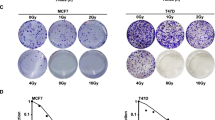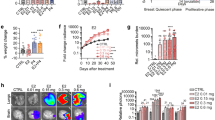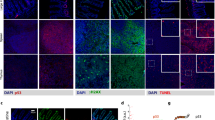Abstract
DNA damage normally induces p53 activity, but responses to ionizing radiation in the mammary epithelium vary among developmental stages. The following studies examined the hormones and growth factors that regulate radiation-responsiveness of p53 in mouse mammary epithelium. Immunoreactive p21/WAF1 and TUNEL staining were used as indicators of p53 activity following exposure to ionizing radiation. In ovariectomized mice, radiation-induced accumulation of p21/WAF1 was minimal in the mammary epithelial cells (<1%). Systemic injections of estrogen and progesterone (E+P) for 72 h were necessary to recover maximal expression of p21/WAF1 following ionizing radiation (55%). The effects of E+P on radiation-induced p21/WAF1 were p53-dependent as responses were absent in Trp53−/− mice. Though hormonal treatments stimulated increases in the proportion of cycling cells (PCNA-positive), this was not directly correlated with p53 activity. Whole organ cultures were used to determine whether E+P act directly upon the mammary gland. Treatment with E+P was sufficient to render p53 responsive to radiation, but TGF-β-neutralizing antibodies blocked responsiveness. In the absence of E+P, TGF-β1 alone did not alter p53 activity. These results demonstrate that estrogen and progesterone together with TGF-β signaling are necessary for maintenance of p53 activity in the mammary epithelium.
This is a preview of subscription content, access via your institution
Access options
Subscribe to this journal
Receive 50 print issues and online access
$259.00 per year
only $5.18 per issue
Buy this article
- Purchase on Springer Link
- Instant access to full article PDF
Prices may be subject to local taxes which are calculated during checkout





Similar content being viewed by others
References
Anderson E and Clarke RB . (2004). J. Mammary Gland Biol. Neoplasia, 9, 3–13.
Barcellos-Hoff MH . (2003). Br. Cancer Res., 5 (Suppl. 1), 33.
Bedford JS and Dewey WC . (2002). Radiat. Res., 158, 251–291.
Bode AM and Dong Z . (2004). Mutat. Res., 555, 33–51.
Celis JE and Celis A . (1985). Proc. Natl. Acad. Sci. USA, 82, 3262–3266.
Chomczynski P and Sacchi N . (1987). Anal. Biochem., 162, 156–159.
Clarke RB, Howell A and Anderson E . (1997). Breast Cancer Res. Treat., 45, 121–133.
Cordenonsi M, Dupont S, Maretto S, Insinga A, Imbriano C and Piccolo S . (2003). Cell, 113, 301–314.
Dibbs KI, Sadovsky Y, Li XJ, Koide SS, Adler S and Fuchs AR . (1995). Am. J. Obstet. Gynecol., 173, 134–140.
Ewan KB, Henshall-Powell RL, Ravani SA, Pajares MJ, Arteaga C, Warters R, Akhurst RJ and Barcellos-Hoff MH . (2002a). Cancer Res., 62, 5627–5631.
Ewan KB, Shyamala G, Ravani SA, Tang Y, Akhurst R, Wakefield L and Barcellos-Hoff MH . (2002b). Am. J. Pathol., 160, 2081–2093.
Goepfert TM, McCarthy M, Kittrell FS, Stephens C, Ullrich RL, Brinkley BR and Medina D . (2000). FASEB J., 14, 2221–2229.
Iatropoulos MJ and Williams GM . (1996). Exp. Toxicol. Pathol., 48, 175–181.
Jeng MH, Langan-Fahey SM and Jordan VC . (1993). Endocrinology, 132, 2622–2630.
Jerry DJ, Kittrell FS, Kuperwasser C, Laucirica R, Dickinson ES, Bonilla PJ, Butel JS and Medina D . (2000). Oncogene, 19, 1052–1058.
Jerry DJ, Kuperwasser C, Downing SR, Pinkas J, He C, Dickinson ES, Marconi S and Naber SP . (1998). Oncogene, 17, 2305–2312.
Jerry DJ, Minter LM, Becker KA and Blackburn AC . (2002). Breast Cancer Res., 4, 91–94.
Kastan MB, Zhan Q, El Deiry WS, Carrier F, Jacks T, Walsh WV, Plunkett BS, Vogelstein B and Fornace AJ . (1992). Cell, 71, 587–597.
Kuperwasser C, Pinkas J, Hurlbut GD, Naber SP and Jerry DJ . (2000). Cancer Res., 60, 2723–2729.
Lanari C, Luthy I, Lamb CA, Fabris V, Pagano E, Helguero LA, Sanjuan N, Merani S and Molinolo AA . (2001). Cancer Res., 61, 293–302.
Liu G, Schwartz JA and Brooks SC . (2000). Cancer Res., 60, 1810–1814.
Liu Y, Chen JJ, Gao Q, Dalal S, Hong Y, Mansur CP, Band V and Androphy EJ . (1999). J. Virol., 73, 7297–7307.
Ljungman M . (2000). Neoplasia, 2, 208–225.
Massague J . (1998). Annu. Rev. Biochem., 67, 753–791.
Matsuda T, Yamamoto T, Muraguchi A and Saatcioglu F . (2001). J. Biol. Chem., 276, 42908–42914.
Medina D and Kittrell FS . (2003). Cancer Res., 63, 6140–6143.
Medina D, Kittrell FS, Shepard A, Contreras A, Rosen JM and Lydon J . (2003). Cancer Res., 63, 1067–1072.
Meijers-Heijboer H, Van Den OA, Klijn J, Wasielewski M, De Snoo A, Oldenburg R, Hollestelle A, Houben M, Crepin E, Veghel-Plandsoen M, Elstrodt F, Van Duijn C, Bartels C, Meijers C, Schutte M, McGuffog L, Thompson D, Easton DF, Sodha N, Seal S, Barfoot R, Mangion J, Chang-Claude J, Eccles D, Eeles R, Evans DG, Houlston R, Murday V, Narod S, Peretz T, Peto J, Phelan C, Zhang HX, Szabo C, Devilee P, Goldgar D, Futreal PA, Nathanson KL, Weber BL, Rahman N and Stratton MR . (2002). Nat. Genet., 31, 55–59.
Minter LM, Dickinson ES, Naber SP and Jerry DJ . (2002). Development, 129, 2997–3008.
Pati D, Haddad BR, Haegele A, Thompson H, Kittrell FS, Shepard A, Montagna C, Zhang N, Ge G, Otta SK, McCarthy M, Ullrich RL and Medina D . (2004). Cancer Res., 64, 5608–5616.
Pierce Jr DF, Gorska AE, Chytil A, Meise KS, Page DL, Coffey Jr RJ and Moses HL . (1995). Proc. Natl. Acad. Sci. USA, 92, 4254–4258.
Rosner B, Colditz GA and Willett WC . (1994). Am. J. Epidemiol., 139, 819–835.
Russo IH, Koszalka M and Russo J . (1990). J. Natl. Cancer Inst., 82, 1286–1289.
Russo J, Ao X, Grill C and Russo IH . (1999). Breast Cancer Res. Treat., 53, 217–227.
Said TK, Conneely OM, Medina D, O’Malley BW and Lydon JP . (1997). Endocrinology, 138, 3933–3939.
Sartorius CA, Takimoto GS, Richer JK, Tung L and Horwitz KB . (2000). J. Mol. Endocrinol., 24, 165–182.
Schairer C, Lubin J, Troisi R, Sturgeon S, Brinton L and Hoover R . (2000). JAMA, 283, 485–491.
Sivaraman L, Conneely OM, Medina D and O’Malley BW . (2001). Proc. Natl. Acad. Sci. USA, 98, 12379–12384.
Sivaraman L, Stephens LC, Markaverich BM, Clark JA, Krnacik S, Conneely OM, O’Malley BW and Medina D . (1998). Carcinogenesis, 19, 1573–1581.
Stavridi ES, Chehab NH, Malikzay A and Halazonetis TD . (2001). Cancer Res, 61, 7030–7033.
Thorstenson YR, Roxas A, Kroiss R, Jenkins MA, Yu KM, Bachrich T, Muhr D, Wayne TL, Chu G, Davis RW, Wagner TM and Oefner PJ . (2003). Cancer Res, 63, 3325–3333.
Thurston SJ and Saffer JD . (1989). Anal. Biochem., 178, 41–42.
Waterman MJ, Stavridi ES, Waterman JL and Halazonetis TD . (1998). Nat. Genet., 19, 175–178.
Wilson JW, Pritchard DM, Hickman JA and Potten CS . (1998). Am. J. Pathol., 153, 899–909.
Wu L, Wu Y, Gathings B, Wan M, Li X, Grizzle W, Liu Z, Lu C, Mao Z and Cao X . (2003). J. Biol. Chem., 278, 15192–15200.
Yamamoto T, Saatcioglu F and Matsuda T . (2002). Endocrinology, 143, 2635–2642.
Acknowledgements
We thank Amy Roberts for providing p53-deficient mice for these experiments. Brooke Pazik provided technical assistance with immunohistology. We thank Michael Sutherland from the Statistical Consulting Center for his assistance. We also thank Lauren Withington, Lawrence Sandi, Kathryn Levaseure, and Jennifer Cohen, undergraduates who participated in this work. This work was supported by grants to DJJ from the National Institutes of Health (CA87531, CA095164), the Massachusetts Department of Public Health (43088PPP1017), and the Charlotte Geyer Foundation with additional support from the Cooperative State Research Extension, Education Service, US Department of Agriculture, Massachusetts Agricultural Experiment Station and Department of Veterinary and Animal Sciences under Project Nos. MAS00821 and NC-1010.
Author information
Authors and Affiliations
Corresponding author
Rights and permissions
About this article
Cite this article
Becker, K., Lu, S., Dickinson, E. et al. Estrogen and progesterone regulate radiation-induced p53 activity in mammary epithelium through TGF-β-dependent pathways. Oncogene 24, 6345–6353 (2005). https://doi.org/10.1038/sj.onc.1208787
Received:
Revised:
Accepted:
Published:
Issue Date:
DOI: https://doi.org/10.1038/sj.onc.1208787
Keywords
This article is cited by
-
Induced mammary cancer in rat models: pathogenesis, genetics, and relevance to female breast cancer
Journal of Mammary Gland Biology and Neoplasia (2022)
-
Genetic modifiers regulating DNA replication and double-strand break repair are associated with differences in mammary tumors in mouse models of Li-Fraumeni syndrome
Oncogene (2021)
-
Inter-Individual Variation in Response to Estrogen in Human Breast Explants
Journal of Mammary Gland Biology and Neoplasia (2020)
-
Estrogen levels act as a rheostat on p53 levels and modulate p53-dependent responses in breast cancer cell lines
Breast Cancer Research and Treatment (2011)
-
The Role of Activin in Mammary Gland Development and Oncogenesis
Journal of Mammary Gland Biology and Neoplasia (2011)



